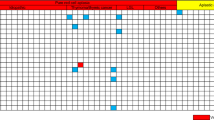Abstract
The authors report a 58-year-old female who originally presented with acquired pure red cell aplasia (PRCA). At diagnosis, the karyotype was normal, the serum erythropoietin level was highly elevated and no T-cell mediated inhibition of erythropoiesis was demonstrated in coculture studies. Conventional immunossupressive therapy proved ineffective. A year later a diagnosis of hyperfibrotic myelodysplastic syndrome was assessed. The sequential bone marrow examinations in the course of the three years showed a progressive increase in bone marrow fibrosis, erythroid hyperplasia and dysmegakaryocytopoiesis, terminating in the acute myeloid leukemia. This sequence of the events included the appearance of del(5)(q13q33), four years after setting a diagnosis of PRCA. The authors suggest that the absence of both cytogenetic abnormality and the signs of dyshematopoiesis at the diagnosis of PRCA does not exclude ultimately a “clonal” category of the disease. Thus, repeated hematological and cytogenetical reevaluations are recommended.
Similar content being viewed by others
Author information
Authors and Affiliations
Additional information
The work was carried out in the Cytogenetics Laboratory and Cell Culture Laboratory of the Institute of Hematology
Rights and permissions
About this article
Cite this article
Suvajdzic, N., Marisavljevic, D., Jovanovic, V. et al. Pure red cell aplasia evolving through the hyperfibrotic myelodysplastic syndrome to the acute myeloid leukemia: some pathogenetic aspects. Hematol Cell Ther 41, 27–29 (1999). https://doi.org/10.1007/s00282-999-0027-5
Received:
Accepted:
Issue Date:
DOI: https://doi.org/10.1007/s00282-999-0027-5




